This spiderweb cake combines rich chocolate cake layers, a tangy cream cheese frosting, and a creepy marshmallow spider web design. It’s much easier than it looks, and you can create the spiderweb easily with just a few basic steps. This cake can be made with all-purpose, whole wheat or gluten-free flour.
This cake might look intimidating, but it’s surprisingly simple to make and easy to decorate.
The cake is the same base I use for all my chocolate cake recipes, including my Chocolate Heart Cake, Jack Skellington Cake, and Dairy-free Cake.
It’s adapted from the recipe on the back of a Hershey’s cocoa powder box. It really is the perfect chocolate cake! And that’s why I keep reusing it.
The orange frosting and easy spiderweb are an easy way to transform this cake into the perfect Halloween treat. If you’re looking for something quicker, this Halloween Cookie Cake (but without the Meringue Ghosts) is a great option.
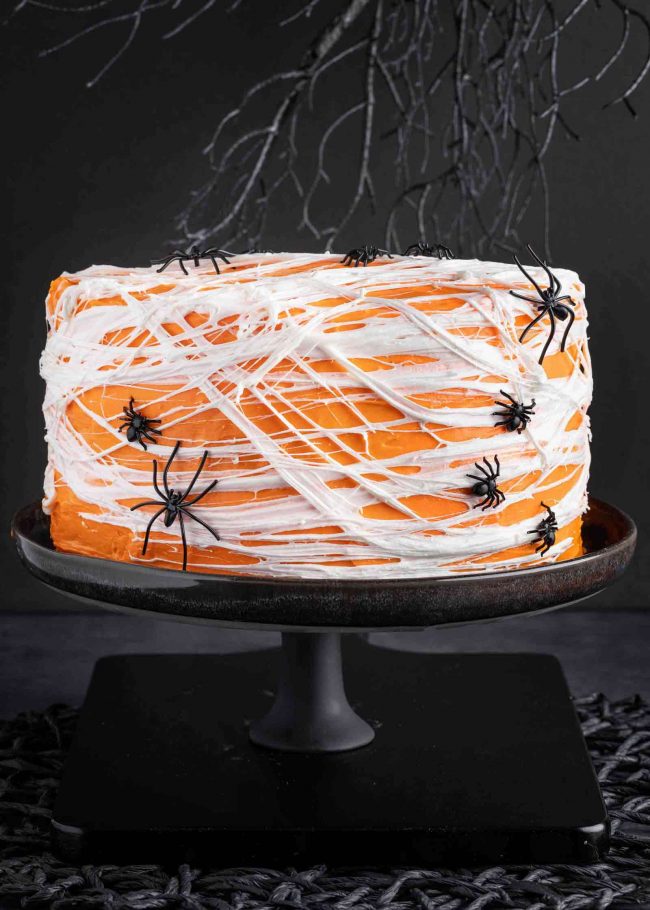
Ingredients
Here’s a look at all the ingredients you’ll need to make this spiderweb cake. For full measurements and instructions, scroll to the recipe box at the bottom of the page.
If you don’t have black cocoa powder, you can use more Dutch-process cocoa powder. Or regular cocoa powder.
Your cake will, of course, be lighter in color and flavor if using all Dutch-process and even lighter if using regular cocoa powder.
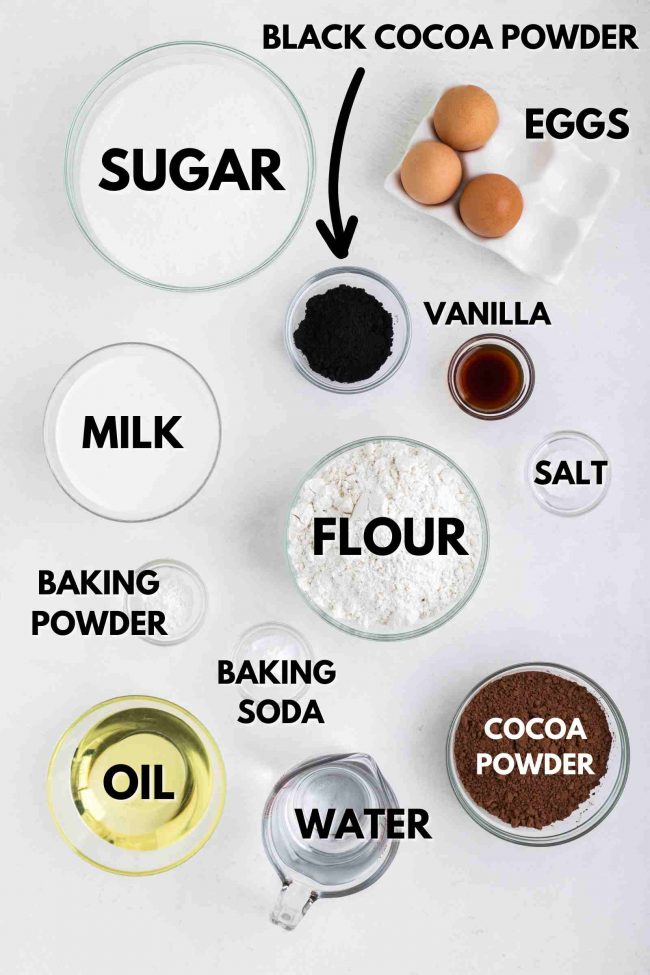
And here’s what you need to make the frosting and to decorate the cake.
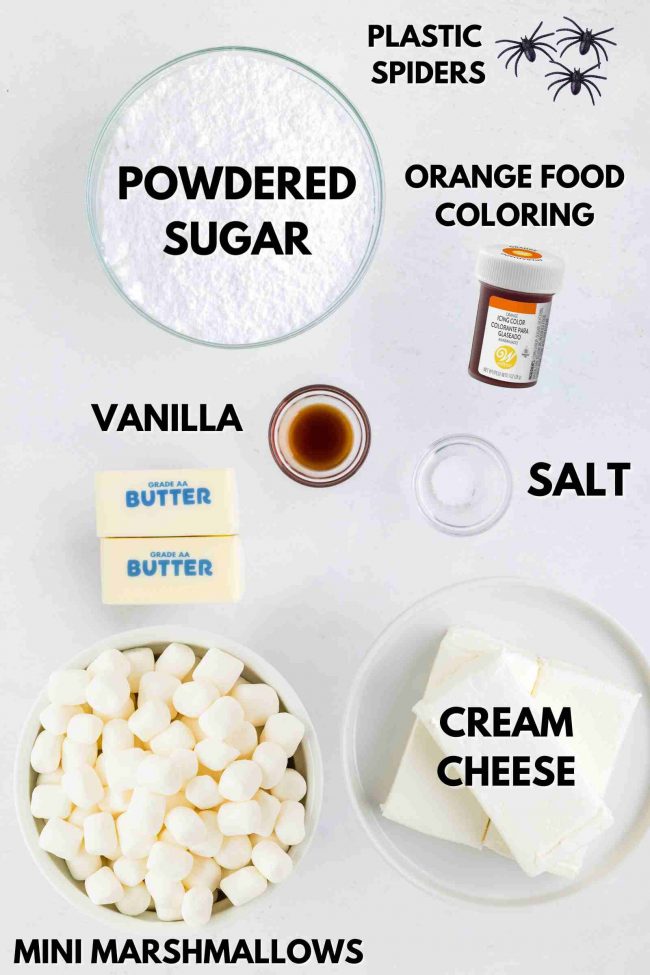
Black cocoa
Black cocoa’s dark color and intense chocolate flavor set it apart from traditional cocoa. It’s what gives Oreo that special flavor.
If you want to make the most of your black cocoa, I have some additional recipes that feature it, like these Black Cookies, a Black Milkshake, and this Black Ice Cream.
Note that as black cocoa powder passes through your digestive system, it doesn’t lose color. There’s no need for alarm.
And as I said above, you can use regular or Dutch-process flour in its place. The purpose in this recipe is to just make the cake darker in color.
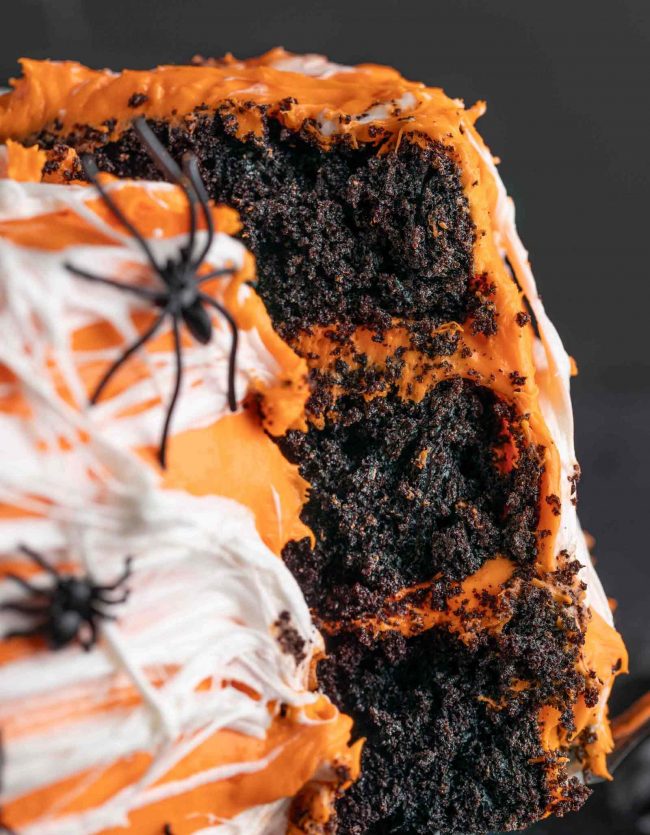
Why use mini marshmallows?
Mini marshmallows are preferred over jumbo marshmallows for a spiderweb cake because they melt more evenly and quickly, making it easier to create the delicate, thin strands that resemble a spiderweb.
Jumbo marshmallows take longer to melt and can result in thicker, clumpier lines that are harder to work with, whereas mini marshmallows allow for better control and precision when stretching them over the cake.
How to make it
As I said before, the full directions are below.
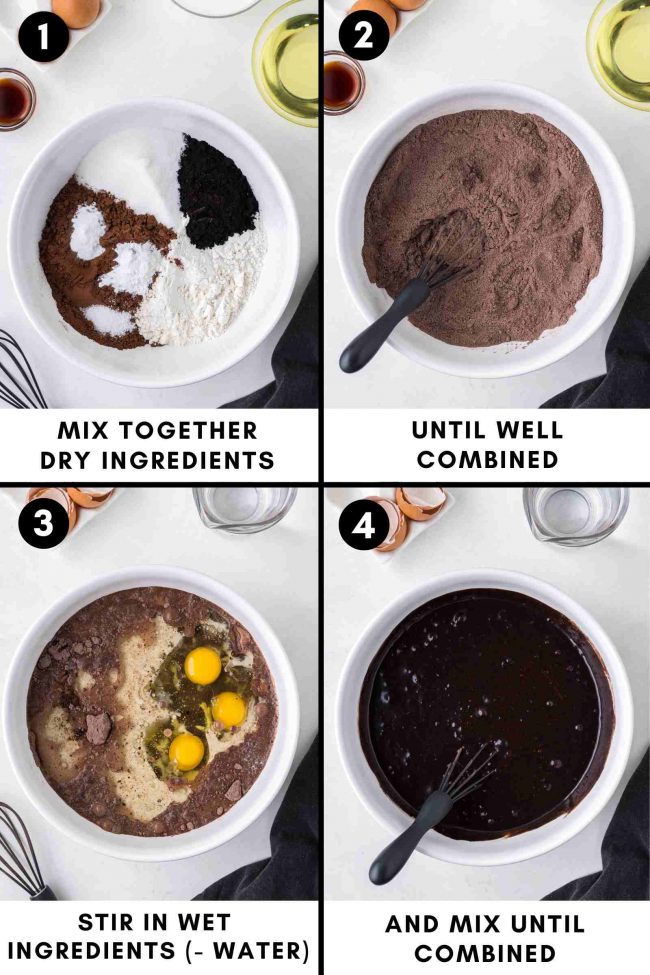
This is just to give you a visual overview.
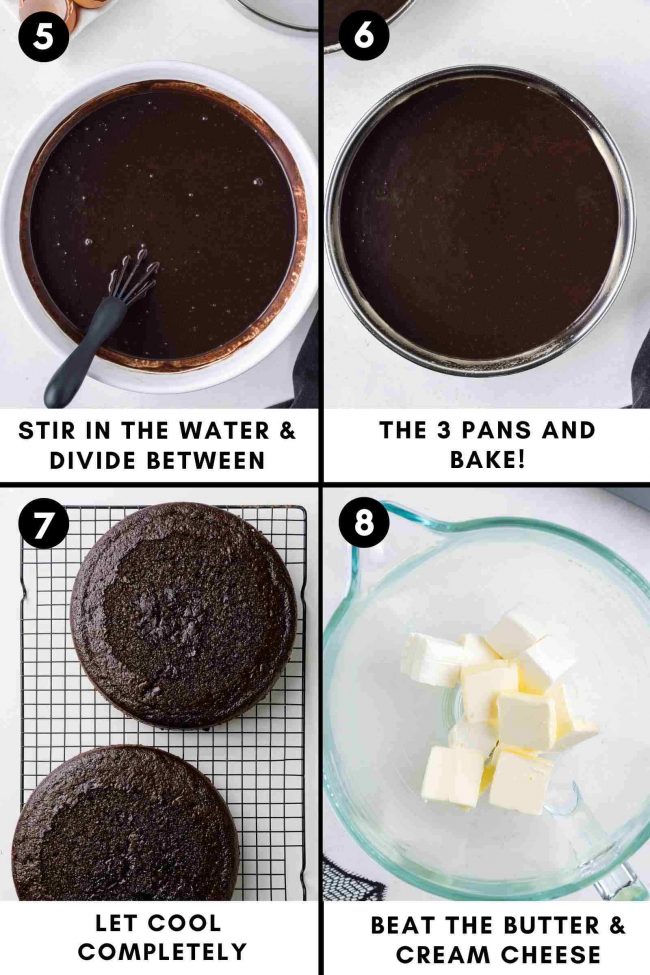
And is not meant as a substitute for the actual directions. 😉
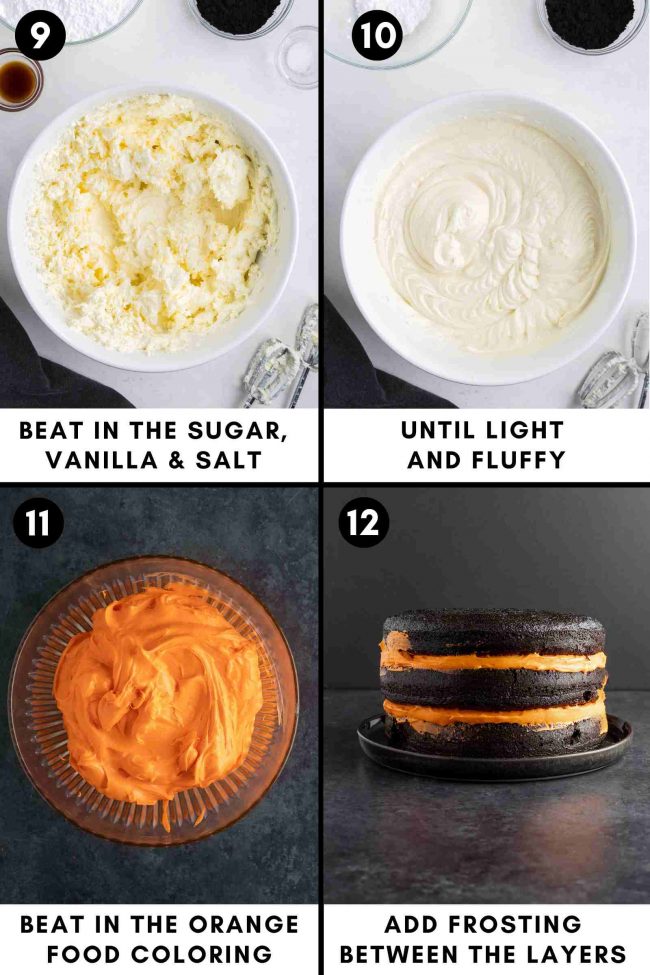
I’ll say it again – this cake is really easy. If piping frosting onto a cake seems intimidating, this is the perfect for you. You can’t really mess it up unless you get sloppy with the spiderweb.
I saw one person’s spiderweb cake that looked a bit like snot. Snot is not the look you’re going for. 😀
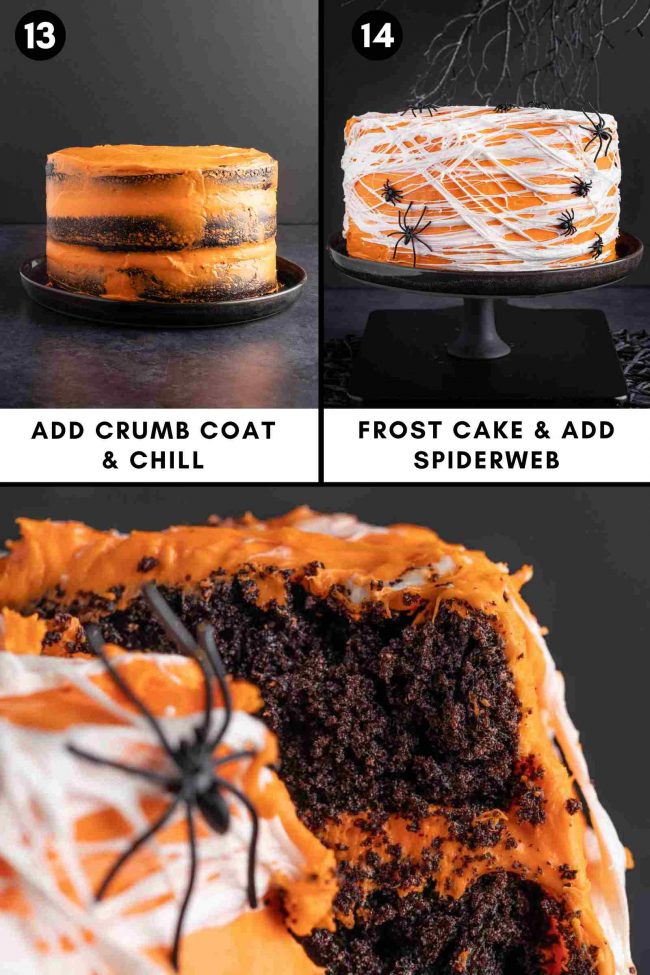
What’s a crumb coat?
A crumb coat is a thin layer of frosting that seals in any loose crumbs, creating a smoother surface for the final frosting. It also helps the frosting adhere more effectively.
Freezing the cake layers makes for a cleaner crumb coat.
After applying the crumb coat, freeze the cake for at least 20-30 minutes before adding the final layer of frosting.
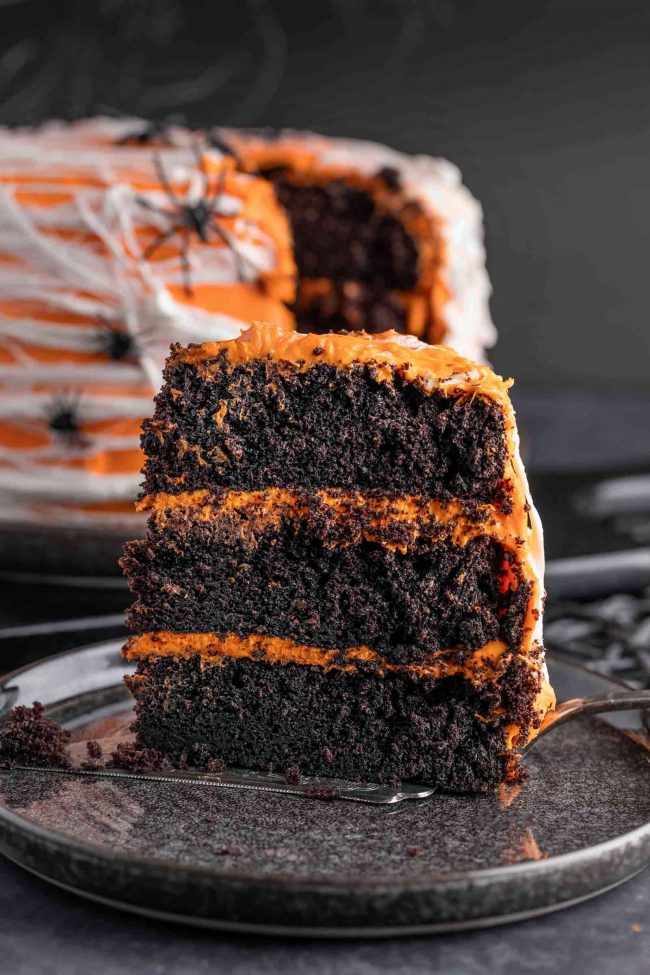
How to make the marshmallow spiderweb
You must use normal marshmallows! I was hoping it’d work with vegan marshmallows, but it didn’t.
I could only get something like 1″ spiderweb strands. I tried them with Koro marshmallows and the ones from a Germany company called Süss und Clever (for the 24 people reading from Germany – those marshmallows were incredible, by the way – my whole family dislikes regular marshmallows and loved these!)
I only found this out last minute. I had promised to bring a cake for my son’s last day of kindergarten, and I had to throw on some other decorations because the vegan marshmallows didn’t do the trick.
To create the spiderweb design, melt mini marshmallows in the microwave and stir. They should be smooth and stretchy.
Let the goo cool slightly so it’s not too hot to touch, put on food-handling gloves, then stretch small pieces between your fingers to form web-like strands.
Carefully drape the strands across your cake, layering them for a realistic marshmallow spider web effect.
If the marshmallows harden, just reheat it briefly in the microwave again.
Use a toothpick to adjust and refine the web strands if needed.
Top with plastic spiders for the final spooky touch! But remove them before you serve.
Note that the spiders can stick to the webbing, so be careful when you take them off.
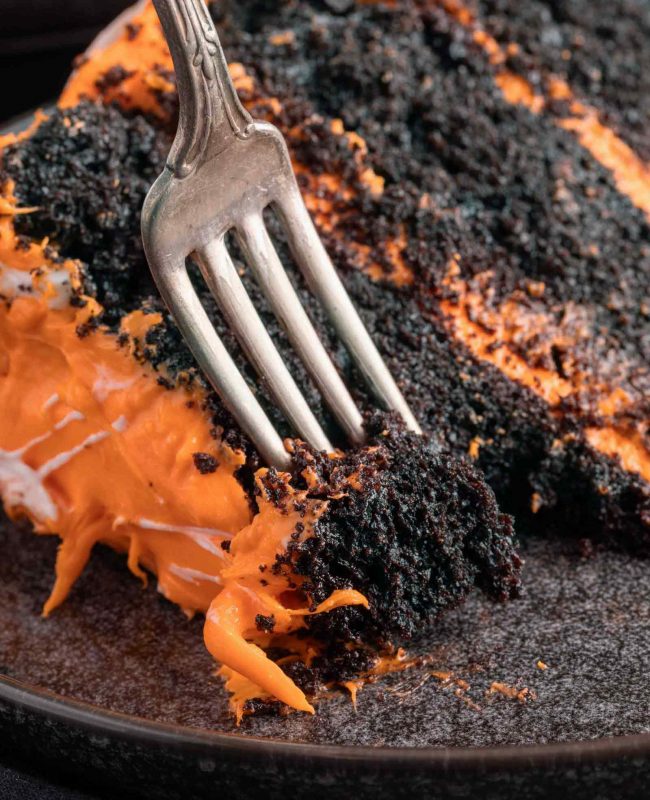
How to make ahead, freeze and store
Making the cake in stages over 2 days makes the process much easier, but you can certainly go from start to finish in one day.
And as a bonus, chilled or frozen cake layers are much easier to frost than those stored at room temperature.
Personally, I like to bake the cake layers and make the cream cheese frosting one day and then decorate the day of serving.
This helps me avoid feeling rushed. I made the Jack Skellington cake last week for our Halloween party, and as always, I was in a huge rush.
The stripes on the side were laughable. I didn’t even read all the instructions that I took forever to write up to ensure everyone is successful with their cake.
I put the cake on a wavy cake stand which prevented me from being able to use a bench scraper to smooth out the stripes. It was absurd. But still tasty! Nobody seemed sad about it except me. 😆
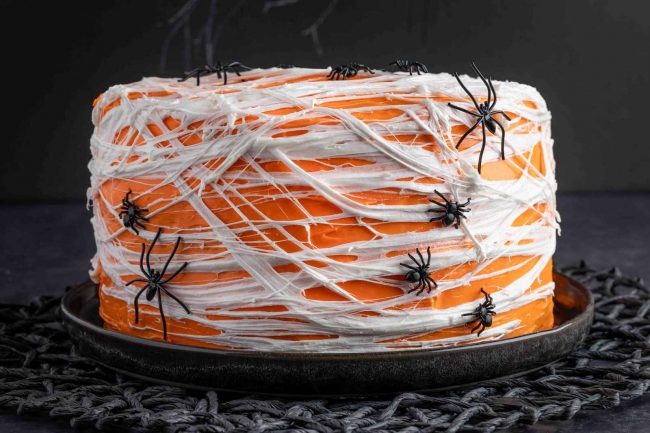
So here’s how much ahead of time you can prepare each element.
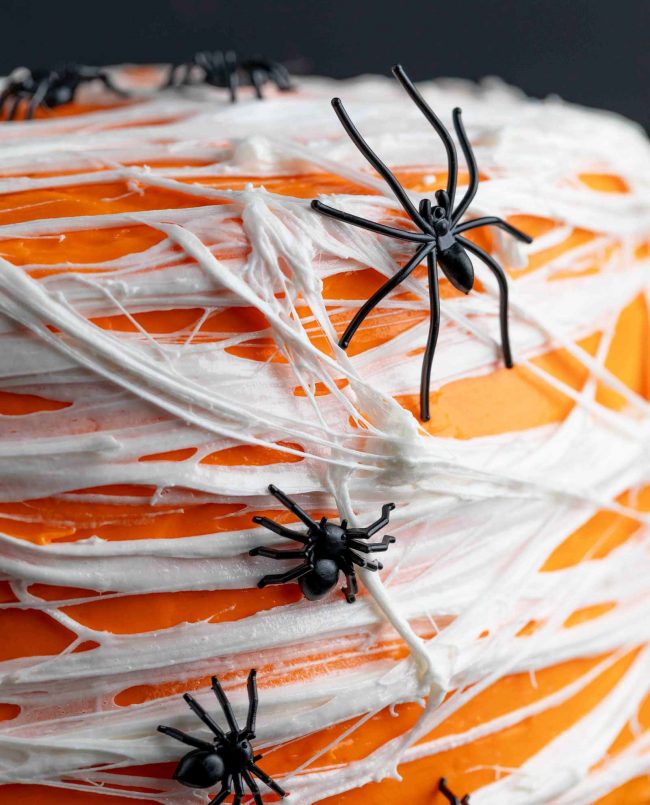
Food coloring
You can use natural food coloring, such as Supernatural Kitchen Food Colors ($35.68/oz) or Color Kitchen ($31.80/oz), for the frosting. I’ve tested this cream cheese frosting with both and the colors come out nice and vivid.
But both options are on the pricey side. I like to stock up when iHerb has a big sale. Both brands have worked well in everything I’ve tried so far.
I used Color Kitchen for the photo below. I took this at our Halloween party on Saturday. It’s the disaster Jack Skellington cake I mentioned above.
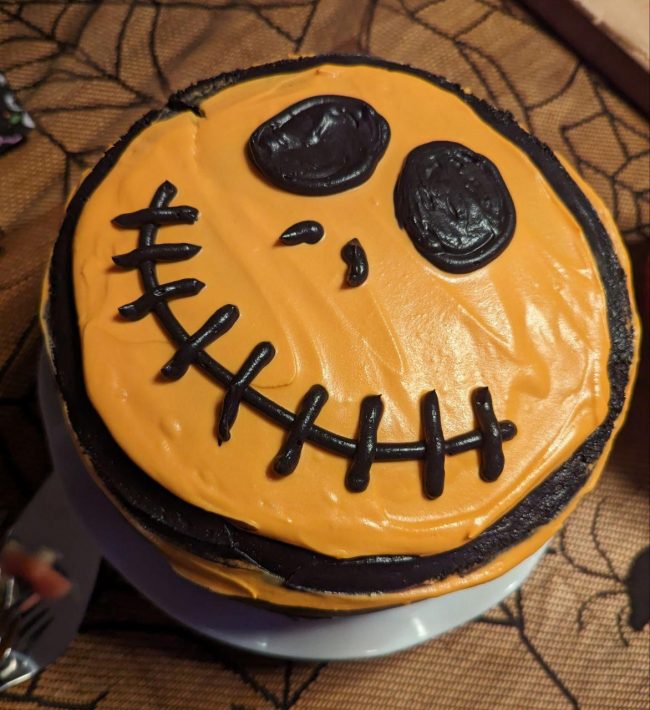
And here’s the kindergarten cake I mentioned above, using Color Kitchen for the orange and green and Supernatural for the purple. The lighting is terrible in both photos, so it’s hard to judge the colors.
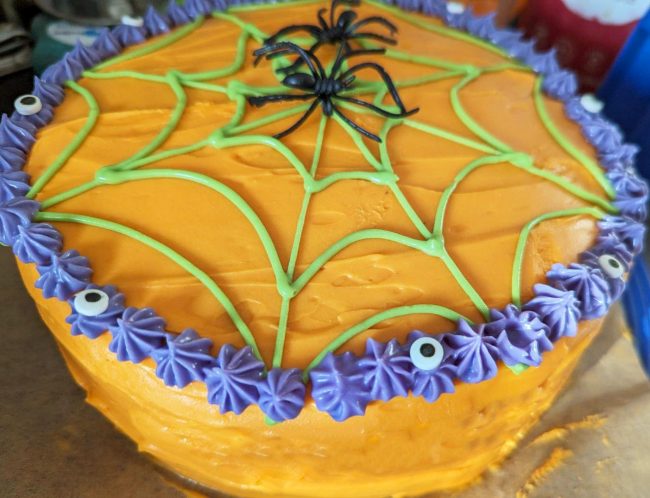
But they both looked great in real life!
I had considered ordering some Color Kitchen for the photographer to use in this recipe, but when I saw the full price, I decided against it.
Last year, I spent over $100 on natural food coloring for photographers, only to have some disappear before even using it. So I’m done with that! 😆
Gluten-free option
My go-to is usually King Arthur Flour Gluten-free Measure for Measure Flour, which often performs better than Bob’s Red Mill 1-to-1 Gluten-free Baking Flour, but not in this recipe.
After 7 failed attempts — where the cake either collapsed as it cooled or turned out overly sticky — I tried adjusting the baking powder, baking soda, water, flour, and black cocoa with no success.
In the end, I switched to Bob’s Red Mill and it worked right away. The batter was stickier than usual, which I attributed to the black cocoa powder.
After some research, I discovered that reducing the amounts of baking soda, baking powder, and water could solve the issue. And it did!
Most marshmallows are gluten-free because in the US they are mostly made with cornstarch instead of wheat starch or byproduct.
Some brands say they are gluten-free, so if you’re baking a gluten-free spiderweb cake, then be sure to look for gluten-free.
Just read the labels and ensure there aren’t added flavorings or any ingredients that contain gluten.
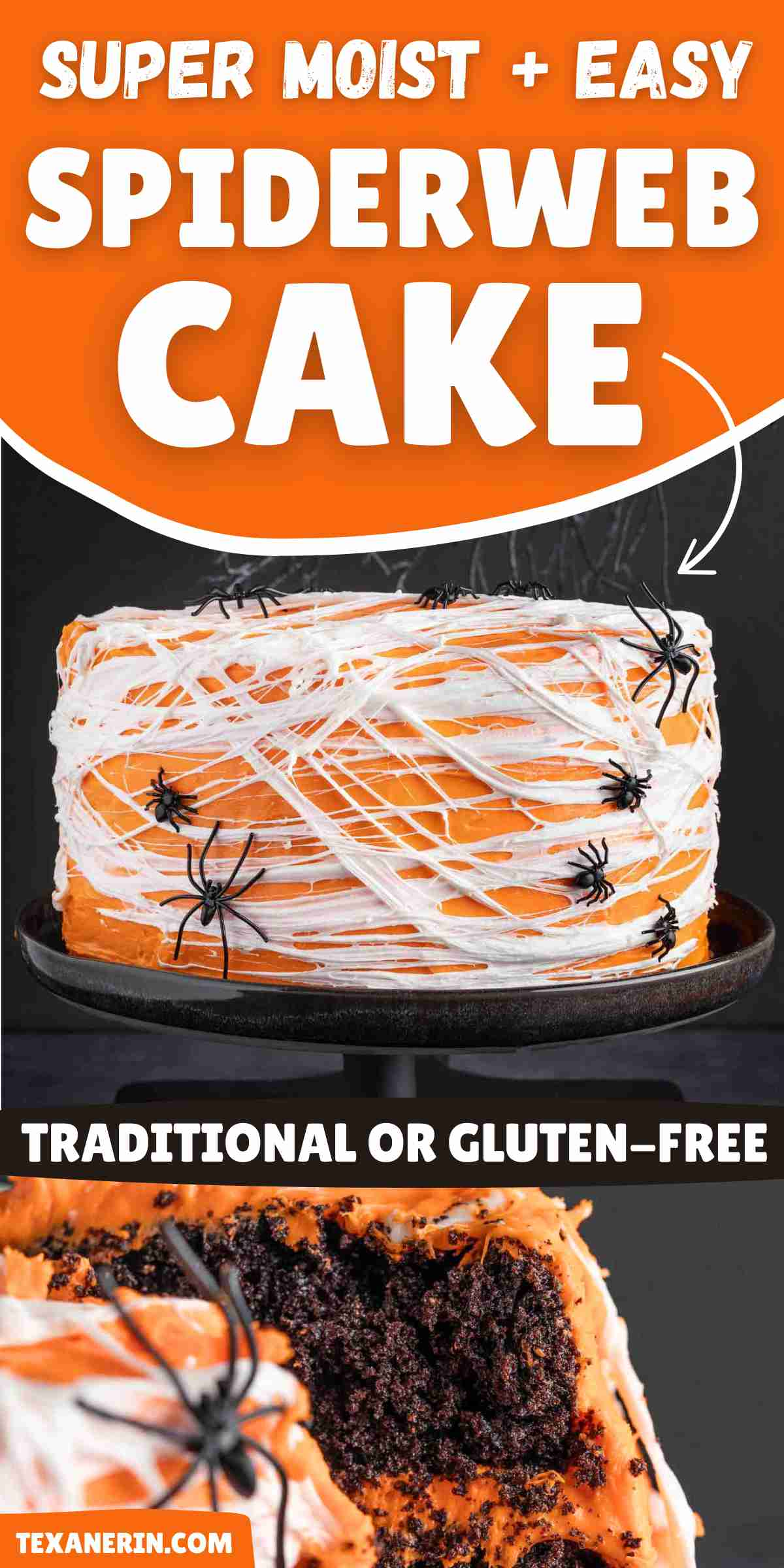
More spider desserts
I hope you’ll enjoy this spiderweb cake! If you try it out, I’d love to hear your thoughts below in the comments. Thanks! 🙂
❀
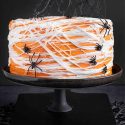
- Prep Time:
- Cook Time:
- Ready in:
- Yield: 12 slices
Ingredients
- 3 cups (600 grams) granulated sugar
- 2 1/2 cups + 2 tablespoons (328 grams) flour
- 3/4 cup + 2 tbsp (101 grams) Dutch-process cocoa powder
- 1/4 cup (28 grams) black cocoa powder (or more Dutch-process)
- 1 1/2 teaspoons baking powder
- 1 1/2 teaspoons baking soda
- 1 1/2 teaspoons salt
- 3 large (50 grams each, out of shell) eggs, room temp or chia eggs
- 1 1/2 cups (355 ml) milk
- 3/4 cup (177 ml) olive, canola or vegetable oil
- 1 tablespoon vanilla extract
- 1 cup + 2 tablespoons (266 grams) boiling water
- 3 (8-ounce) packages (680 grams total) full-fat cream cheese, room temperature
- 1 cup + 2 tablespoons (253 grams) unsalted butter
- 3 3/4 cups (450 grams) powdered sugar (or more if you like)
- 1 1/2 teaspoons vanilla extract
- pinch of salt
- orange food coloring
- 2 cups mini marshmallows
- plastic spiders
Cake:
Frosting:
For the spiderweb:
Directions
- Preheat your oven to 350 °F (175 °C). Line 3 round 8″ cake pans with parchment paper on the bottom and grease the sides.
- In a large bowl, stir together the sugar, flour, Dutch-process cocoa, black cocoa powder, baking powder, baking soda and salt. Add eggs, milk, oil and vanilla.
- Mix until combined, and then stir in the boiling water. The batter will be quite thin.
- Divide the batter between the three pans. That’s 658 grams of batter per pan (675 grams per pan if using Bob’s GF flour).
- Bake for 24-28 minutes or until a toothpick comes out with some moist crumbs but no uncooked liquid.
- Let cool for 10 minutes in the pans, and then turn out onto a rack to cool completely; about 2 hours. My cakes weren’t flat, but not very rounded, either. If you want to, you can level them (I did not).
- In a large mixing bowl, beat the cream cheese and butter together with an electric hand mixer at medium speed until well combined. It’s okay if it looks a little crumbly.
- Gradually beat in the powdered sugar until totally combined, and then beat in the vanilla and salt.
- Beat in a little orange food coloring at a time until you’re happy with the color.
- Place the bottom layer of cake, rounded side down, on the serving dish.
- Spread 1 1/4 cups (288 grams) of frosting over the bottom layer, almost until the edge.
- Put on the next cake layer, rounded side down, and spread the same amount of frosting over the top.
- Place the third cake layer on top, rounded side up.
- Use 1/2 cup (115 grams) of frosting as a crumb coat. Keep the frosting refrigerated until ready to use. And if you ever think it’s not firm enough, place it back in the fridge.
- Spread it all around the cake.
- Place the cake in the freezer for 20-30 minutes after putting on the crumb coat (or 1-2 hours in the fridge). You can also refrigerate it overnight to help break up the workload.
- Then cover with the remaining frosting. Place the cake in the fridge for 4-8 hours, or overnight, so that it’s as firm as possible. How long you need depends on if the cake layers were frozen and if/how long you chilled the frosting before and during the decorating process. With my very warm kitchen and not chilling the cake or the frosting, 4 hours was enough to firm it up. 8 hours would have been better for a cleaner slice.
- Keep in mind that the marshmallow spiderweb can become wet and sticky over time, so it’s best to serve the cake within a few hours of decorating for optimal taste and texture.
- Place the mini marshmallows in a microwave-safe bowl. Microwave on high for about 30-60 seconds, or until the marshmallows are completely melted. Stir well to ensure the marshmallows are smooth and stretchy.
- Allow the melted marshmallows to cool slightly, just until it’s not too hot to handle but still stretchy.
- Put on food-handling gloves, and take a small amount of the melted marshmallow between your fingers. Stretch the marshmallow between your fingers to create thin, web-like strands.
- Gently pull the marshmallow strands across the surface of your frosted cake, wrapping it around the sides and across the top to create a spiderweb effect. You can layer the strands in a crisscross pattern to achieve a more realistic web look.
- If the marshmallows start to harden, you can reheat them briefly in the microwave to regain the stretchiness.
- You can use a toothpick or small tool to help adjust or refine the web strands on the cake if needed.
- Add little plastic spiders. Be aware that they’ll stick to the marshmallow and pull some of it along with the frosting when removed.
- To make slicing through the marshmallow easier, use a serrated knife with a little oil on it, then using a sawing motion to cut the cake.
- If you want to make the cake elements in advance, let the layers cool, wrap the layers individually in plastic wrap and place inside a Ziploc bag. They can be stored at room temperature for up to 2 days, refrigerated for 3, or frozen for 3 months. No need to defrost before assembling the cake.
- The frosting can be refrigerated for up to 4 days total or frozen for up to 3 months.
- You can assemble the cake, add the crumb coat and frosting and then freeze it for up to a week. I would wrap it in plastic wrap and then place it in a big bag, just to be safe. The spiderweb should be added as close to serving as possible. If you have any leftovers, it’s safe to refrigerate and freeze the cake with the spiderweb on it, but you probably won’t want to serve it as it’ll be a mess.
Make the cake:
Prepare the frosting:
Assemble the cake:
Crumb coat:
Make the spiderweb:
How to store:
Notes
- You can use all-purpose flour, white whole wheat flour or whole wheat flour. If you’re gluten-free, use, use 2 1/2 cups + 2 tablespoons (363 grams) Bob’s Red Mill 1-to-1 Gluten-free Baking Flour
- To make the chia eggs for this recipe, mix together 3 tablespoons of ground chia seed with 1/2 cup + 1 tablespoon (133 grams) of water until well combined. Let sit for about 1-2 minutes or until goopy like regular eggs.
- You can use whatever type of milk you want. If you using canned coconut milk, water it down so that it’s runny like regular milk.
- If you live outside of the US – you likely have a different type of cream cheese than in the US. US cream cheese is firmer and meant for baking, rather than the kind for toast, like in Europe. For 8 ounces (225 grams) of cream cheese, buy a 300-gram package (the stuff at Aldi, Lidl, etc. works just as well as Philadelphia), put it in the center of a clean tea towel or cheesecloth, and squeeze out the liquid until you have 225 grams of cream cheese. So for this recipe, buy 900 grams of cream cheese and squeeze out the liquid until you have 680 grams of cream cheese left. Also note that medium eggs in the EU = US large eggs. You if you’re in the EU, you need medium eggs.
- I tried this recipe with 2 brands of healthier vegan marshmallows, and it didn’t work. You need to use regular marshmallows.
Cake base adapted from Hershey’s One Bowl Chocolate Cake

